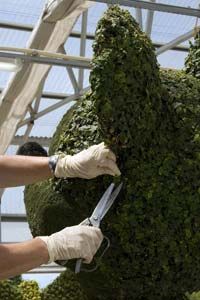How to Make Traditional Topiary
To begin your own traditional topiary project, figure out where you want to plant your topiary, and choose the type of plant you'd like to shape. Dense evergreen plants that can withstand shearing and grow easily are best for topiary. Topiarists most commonly use boxwood and yew for traditional shrub topiary, but other plants and even herbs such as rosemary also work well. Take the climate, soil and shade in your garden into account, and consider using multiple plants if you want to create and support very large or complex projects like elephants or archways.
Next, choose a design. Some plants' growth may suggest a design, or you may want to train your plant to best fit the setting in which it will grow. Consider other features and plants in your garden as well as the style of your home and maintenance. Remember that while your plant may start small, it will continue to grow over the years. Some shapes may require more upkeep than others to remain visually appealing.
Advertisement
Clipping tools used to create and maintain traditional topiary range from hand tools like secateurs (pruners) and shears to electric- and gas-powered clippers. Choose your clipping tools based on the amount of work your project requires. While hand-powered tools are best for small projects and give you more control, you may want gas- or electric-powered clippers for trimming down very large shrubs or trees. When shopping for either type of tool, make sure they are comfortable in your hands and are not too heavy for use over prolonged periods of time.
It is important to remember safety when working with these sharp tools. Wear gloves to protect your hands, and consider eye and ear protection, especially if you're using motorized clippers. When using electric clippers, know where the cord is at all times in order to avoid accidentally cutting through it, which can lead to electrocution.
When working with traditional topiary, you may want to buy wooden canes or metal frames, which you can use to shape your plant or train its stems. To make cleanup easier, you can also lay tarps under your plants while you trim.
Naturally, different designs require different steps. Here's how you'd create a basic, cone-shaped traditional topiary from boxwood:
- Start with one young boxwood, or plant several small boxwoods together so they will grow close enough to look like one shape. Plant the boxwood in the ground or a soil-filled pot.
- Place a cone-shaped frame, which you can purchase or construct using poles or wire, over the plants. Anchor the frame into the soil.
- Feed and water your plant. As your creation grows, use pruning shears to cut any branches that grow past the frame.
- The plant will fill the frame over time. Allow the plant to grow just past the frame in order to hide it.
